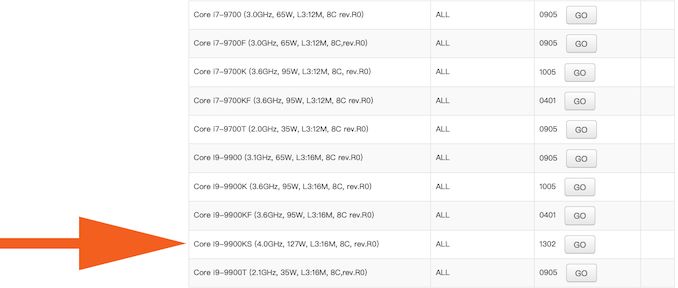Intel Core i9-9900KS TDP Details: ASUS Maximus XI Apex Support
by Anton Shilov on September 18, 2019 9:30 AM EST- Posted in
- CPUs
- Intel
- Motherboards
- Coffee Lake
- Coffee Lake Refresh
- i9-9900KS

Intel announced plans to launch its eight-core Core i9-9900KS processor along with its performance specifications quite a while ago, but the company did not disclose the TDP. As the processor will have an all-core base frequency of 4.0 GHz and an all-core turbo of 5.0 GHz, this number is vitally important for motherboard support. This week ASUS released a new BIOS version for some of its motherboards that adds support for the Core i9-9900KS and revealed the number.
The Intel Core i9-9900 processor has a base frequency of 4.0 GHz as well as an all-core turbo frequency of 5.0 GHz, which essentially makes it an eight-core Coffee Lake Refresh silicon binned to hit higher clocks when cooling is good enough. As it turns out, in a bid to enable higher frequencies, Intel has increased the TDP all the way to 127 W (according to a listing at ASUS.com), which is considerably higher when compared to any existing (or historical) Intel’s CPU for mainstream platforms.
One thing that should be noted is that Intel only guarantees base frequency at a rated TDP (e.g., 4.0 GHz at 127 W), so everything above base (i.e., turbo clocks) means a higher power consumption. As a result, not only will the Core i9-9900KS require a motherboard that can supply 127 W of power and a cooling system that will dissipate 127 W of power, but it will need an advanced platform to hit the turbo clocks. Fortunately, there are plenty of high-end motherboards and coolers around to support the Core i9-9900KS.
| Intel 9th Gen Core 8-Core Desktop CPUs | ||||||||
| AnandTech | Cores | Base Freq |
All-Core Turbo | Single Core Turbo Freq |
IGP | DDR4 | TDP | Price (1ku) |
| i9-9900KS | 8 / 16 | 4.0 GHz | 5.0 GHz | 5.0 GHz | UHD 630 | 2666 | 127 W | ? |
| i9-9900K | 8 / 16 | 3.6 GHz | 4.7 GHz | 5.0 GHz | UHD 630 | 2666 | 95 W | $488 |
| i9-9900KF | 8 / 16 | 3.6 GHz | 4.7 GHz | 5.0 GHz | - | 2666 | 95 W | $488 |
| i7-9700K | 8 / 8 | 3.6 GHz | 4.6 GHz | 4.9 GHz | UHD 630 | 2666 | 95 W | $374 |
| i7-9700KF | 8 / 8 | 3.6 GHz | 4.6 GHz | 4.9 GHz | - | 2666 | 95 W | $374 |
One thing to keep in mind is that the information about the TDP of the Core i9-9900KS comes from a third party (albeit a very reliable one), not from Intel. Intel has confirmed that the new Core i9-9900KS will be released in October.
Related Reading:
- Why Intel Processors Draw More Power Than Expected: TDP and Turbo Explained
- Intel to Launch Core i9-9900KS Next Month: 5 GHz on All Cores
- Intel Announces 8 Core i9-9900KS: Every Core at 5.0 GHz, All The Time
- The Intel 9th Gen Review: Core i9-9900K, Core i7-9700K and Core i5-9600K Tested
- Intel 9th Gen Core Processors: All the Desktop and Mobile 45W CPUs Announced
Source: ASUS













47 Comments
View All Comments
AshlayW - Thursday, September 19, 2019 - link
THey have a huge amount of cost to make up for in the R and D of their process. AMD uses an off the shelf process from GloFo and now, TSMC. It is vastly cheaper for AMD to make Zen than Intel to make Skylake. THe profit from each chip made (BOM, etc) may seem high, but in the long-term development costs of the design and its process (Intel 14nm is the best of its class in the world), are enormous. Long-term profitability may not be as huge as some people think.boozed - Wednesday, September 18, 2019 - link
Intel is ridiculously profitableAshlayW - Thursday, September 19, 2019 - link
AMD can easily drop prices to respond to that. Intel has to pay for its own fabs, too, so they cannot afford to sell them so cheaply, AMD can. This is not a fight Intel can win (value proposition)Gondalf - Wednesday, September 18, 2019 - link
Redo the math. Your post is absolutely wrong in silicon mm2. Intel is 177 mm2, AMD 260/270 mm2 with 16 cores.Flunk - Wednesday, September 18, 2019 - link
Zen 2 is a multi-chip module. 16 cores is 2 74mm² cores and a simple control module that's fabbed on the old 14nm² process (125mm²).What this boils down to is that you get a lot more viable 74mm² cores on a wafer than you do on one monolithic 174mm² core. As such your comment is total nonsense.
DigitalFreak - Wednesday, September 18, 2019 - link
So 127 W TDP from Intel means 250 W of actual power draw.Cellar Door - Wednesday, September 18, 2019 - link
Pretty much - and it is actually funny how they didn't round up at 125watts but added couple more.Under what workload and specific conditions do they even get 127watt TDP?
shabby - Wednesday, September 18, 2019 - link
When turbo is off.Korguz - Wednesday, September 18, 2019 - link
" Under what workload and specific conditions do they even get 127watt TDP " probably when the chip is running at base clocks and barely doing anything, once you put a good load on the chip, up goes the power usage as well.regsEx - Wednesday, September 18, 2019 - link
If that is 127 W, then why new socket for Comet Lake? There are no any more limitations than TDP.